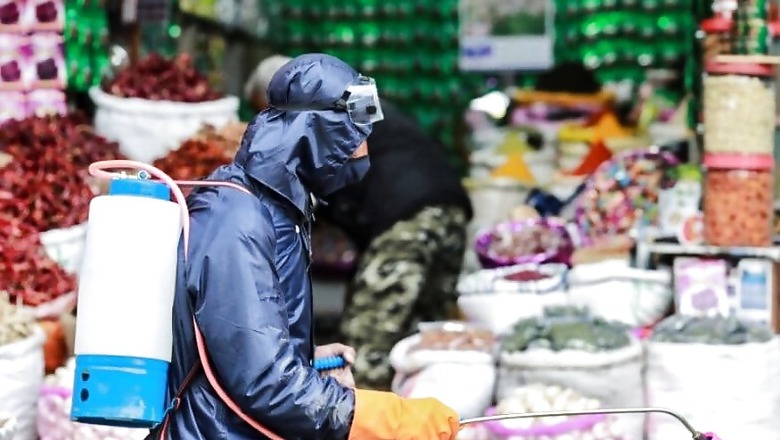
views
Last night, I was listening to one of the many ongoing TV debates on the current COVID-19 pandemic in India. One distinguished public health expert from the US predicted around 300 million cases in India based on certain mathematical models used in the western world.
He went further and predicted 10 million severe infections that will all happen within a two or three-week window. No doubt, we have the 2nd largest population in the world and a fragile health infrastructure, but even then, these statements may be viewed as creating unnecessary scare in the community.
Undoubtedly, the COVID-19 outbreak is exceptional. No other pandemic had gripped the world as firmly as this outbreak. The whole world has come to a standstill. And India is no exception. Many health professionals are forecasting India as the next big hotspot of the COVID-19 pandemic. But still, India has managed to keep the escalation of the disease and the number of fatalities in check.
Saving Grace
If one studies the epidemiology of influenza virus, a respiratory virus with almost similar viral characteristics and route of transmission as the current coronavirus, it is apparent that Indian conditions are not very conducive to its rapid diffusion in the population.
Let’s make a comparative analysis of the burden of annual influenza in the US and India. In 2017-18 season, there were an estimated 49 million cases of influenza-like illnesses, 960,000 hospitalisations and 79,000 deaths in the US whereas corresponding estimated figures for India were 16 million, 83 882, and 28, 000 despite having four times the population of the US.
One may argue that the current virus is far more transmissible than the flu virus, but if we analyse the ‘basic reproduction number’ or ‘Ro’, it is 2-2.5 for the SARS-CoV2 in China and some other severely affected countries which is higher than seasonal flu (Ro: 1-2) but lower than SARS (Ro: 2-5).
One should note that the ‘Ro’ is not a fixed entity, it varies considerably by the environmental conditions, population density and profile of the vulnerable population. Consequently, the SARS-CoV2 may be having a different Ro’ in India than in Europe or some other countries. Take the case of another respiratory virus, the measles, which has a very high ‘Ro’.
India had great difficulty in containing measles despite running a large, mass vaccination program for over 35 years. The very high virulence of measles virus was responsible for the intense transmission of the virus in Indian conditions. The SARS-CoV2 is not as lethal as the measles virus is. The hot, tropical environment in India would have an adverse effect on viral transmission and shedding, and should act as deterrent to the ‘swift’ transmission of SARS-CoV2. In a recently published paper from China, it is noticed that high temperature and high relative humidity significantly reduce the transmission of COVID-19.
The authors conclude that one-degree Celsius increase in temperature and 1% increase in relative humidity lower ‘Ro’ by 0.0383 and 0.0224, respectively. Similar findings were observed when influenza transmission was studied in tropical countries. The epidemiology of the current pandemic also reflects relative sparing of nations having tropical weather such as most countries in Africa and South America.
We may be having a low ‘Ro’ of the currently circulating SARS-CoV2 than in most countries having temperate conditions.
People may argue that the one key difference between seasonal flu and SARS-CoV2 is the zero immunity against the latter since it is a newly introduced virus. But we had a similar experience with ‘swine-flu’ aka H1N1 flu pandemic in 2009-2010 which was not proved as devastating as feared by the most. That pandemic resulted in total 10,193 cases with 1,035 deaths over a year. Considering the extraordinary, unprecedented steps taken by the Government this time, should further limit the damage.
How Deadly is SARS-CoV2?
As per the global data, 16,509 fatalities are reported out of 379,375 total cases giving a fatality rate of 4.4%. India, which has strategized to do limited testing until recently, also have around 2% fatality rate. But these figures are misleading and do not reflect the true virulence of the virus. There is marked variability in the testing strategy of different countries and most barring few have tested only severe cases or those with history of travel to infected countries.
Since as many as 30-40% infections may be asymptomatic or have a mild disease, the denominator seems imperfect. We do not know the exact number of total SARS-CoV-2 infections. In only one instance, the outbreak on Diamond Princess cruise ship in Japan, the death rate was calculated with some precision which came around 1%.
Future Projections
So, what would be the ultimate course of the current pandemic in India? How many cases and deaths would occur? May be difficult to forecast right now considering these are still early days. But one thing that can be most certainly predicted- it would not go the way it went in Italy or Spain. Most of the past flu outbreaks in last five years in India have confined to the first 3-4 months, i.e. till March-April.
We are already in the 7th week of the outbreak and yet to see huge multiplications of the cases. Without resorting to any mathematical modelling, it can be safely assumed that even in the worst-case scenario, we should not go much beyond the past H1N1 tally with around a thousand deaths. Those public health experts who are predicting doom for India with 2-3 million deaths are probably not aware of its peculiar climatic conditions and the course of some recent past pandemics in India.




















Comments
0 comment